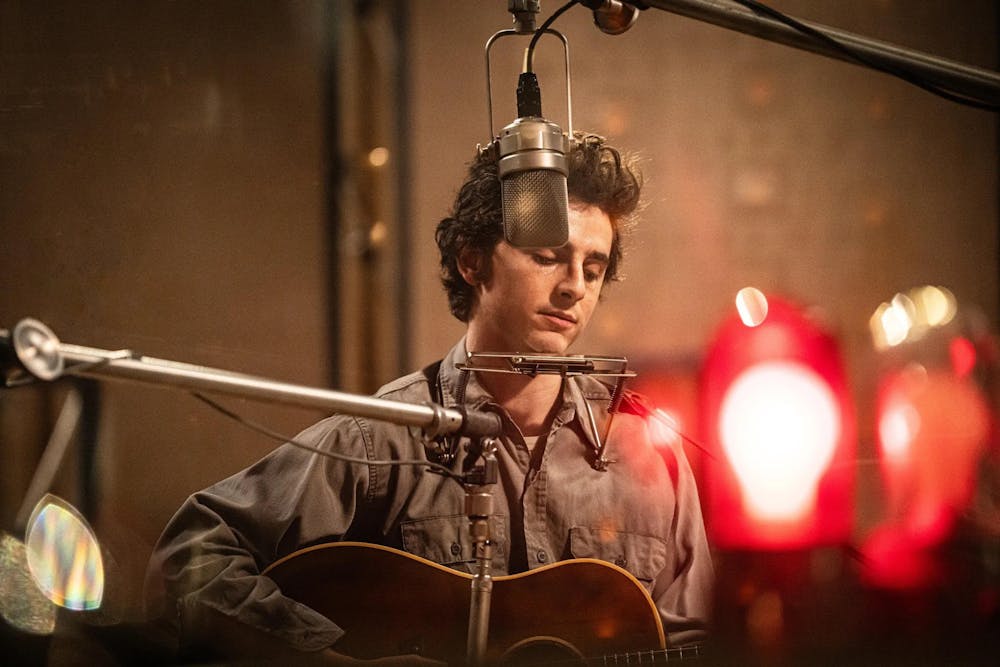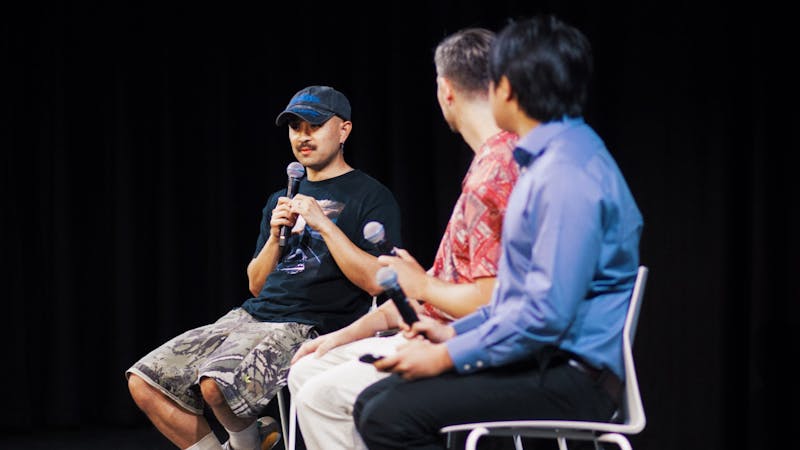Review: Mangold’s Bob Dylan remains ‘A Complete Unknown’

The Academy Awards revealed their nominations Jan. 23, and to the surprise of many, James Mangold’s Bob Dylan biopic walked away with eight. Titled “A Complete Unknown,” the film follows Dylan’s meteoric rise in the 1960s folk scene, culminating in his now-famous transition to electric guitars. Despite the nods from the Academy, Mangold’s film delivers a story that is more style than substance, never fully illuminating the genius behind the shades.
From its opening moments, “A Complete Unknown” hastily checks off major milestones in Dylan’s early career. Dylan (Timothée Chalamet) arrives in New York with little more than a guitar, soon visiting an ailing Woody Guthrie (Scoot McNairy) in the Greystone Park Psychiatric Hospital. Virtually the next scene, he’s taken under the wing of Pete Seeger (Edward Norton) and introduced onstage at the Gaslight, where he meets Joan Baez (Monica Barbaro) and manager Albert Grossman (Dan Fogler).
By the time we meet Sylvie Russo (Elle Fanning) — the film’s fictional stand-in for Dylan’s girlfriend Suze Rotolo — “A Complete Unknown” has covered so much ground that it’s already leaping forward to the mid-’60s with Dylan bursting into his apartment, “Like a Rolling Stone” inexplicably rolling off his tongue.
These legendary moments would feel momentous if they weren’t so rushed, crammed into 140 minutes that play like a greatest hits montage and gloss over Dylan’s inner life and motivations. There was ample opportunity in the first third of the film to provide more insight into who this “complete unknown” really was, but instead, we’re given Wikipedia paragraphs.
While the film never attempts to sanitize Dylan’s infamous prickliness — he’s curt, cryptic and often just an outright jerk — it also doesn’t delve deeper than those traits. Where Todd Haynes’s “I’m Not There” circled Dylan’s elusiveness with six different portrayals, Mangold’s approach keeps Dylan as a static, enigmatic figure orbiting around an ever-spinning carousel of notable events.
Timothée Chalamet’s performance is sure to spark debate: when he’s in performance mode, singing Dylan’s classics live on set, he’s thoroughly engaging — even electrifying. But in dialogue scenes, he leans heavily into Dylan’s idiosyncratic cadence, a choice that vacillates between oddly compelling and distractingly caricatured. He’s incredibly effective at Dylan’s aloof cruelty, yet the film never expands his Dylan beyond the “complete unknown” mystique.
Monica Barbaro’s Joan Baez, meanwhile, receives the film’s most disappointing treatment. Her radical folk artistry and outspoken civil rights activism are minimized, leaving us with a one-note depiction of jealousy and artistic inferiority. A withering insult from Dylan about her songs being “like an oil painting in the dentist’s office” sums up how the film frames Baez: second-best and forever overshadowed.
In reality, Baez was a major figure in the civil rights movement, yet “A Complete Unknown” sanitizes the turbulent politics of the era into a single image of Dylan singing at a protest march. The snub is glaring, especially considering Baez’s far deeper involvement in those struggles. However, Barbaro is fantastic as Baez, imbuing her with fiery defiance in the face of Dylan’s arrogance. Still, a character as remarkable as Baez deserves the same treatment for her artistry and activism and not just her interactions with a male peer.
On a technical level, however, there’s much to admire. Phedon Papamichael’s cinematography vividly recreates the Greenwich Village folk scene, employing deep-focus lenses and dusty color palettes that make every street corner and coffee house feel lived-in. Rather than resembling a polished, high-budget re-creation of the 1960s, the sets look as if they’ve been pulled straight from the era, capturing the scrappy energy and cramped intimacy of a burgeoning music revolution.
Still, this aura of authenticity can be undermined by the film’s more contrived moments — none more so than the scene where Dylan spontaneously conjures “Like a Rolling Stone,” seemingly in one lightning-strike burst of divine inspiration. This scene feels like a cinematic contrivance, sapping away the raw wonder and reducing a legendary moment in music history to a mere Hollywood flourish.
Despite these issues, there is power in the film’s culminating performance at the 1965 Newport Folk Festival. The chaos of Dylan’s electric set — booing fans, a tense Seeger looking on nervously and a loaded Johnny Cash (Boyd Holbrook) egging Dylan into full rock-star rebellion — showcases Mangold’s knack for frenetic, immersive storytelling.
In this sequence, the film captures something vital: the cultural divide that sprang up the moment Dylan plugged in, fracturing the folk scene and sparking a conversation about evolving artistry. It’s a flash of what “A Complete Unknown” could have been with more focus and less box-checking. Ultimately, what Mangold’s biopic does best is evoke a moody, immersive atmosphere. For fans of Bob Dylan’s music, this writer counted among them, the performance scenes provide genuine thrills — each chord a reminder of why Dylan’s work still resonates today.
But beyond the showstopping visuals and the committed cast, the film struggles to illuminate Dylan’s soul, or even fully reckon with the collective spirit of the 1960s that shaped him. Like the title suggests, “A Complete Unknown” is content to leave Dylan’s interiority unexplored. That’s not inherently a flaw — Dylan, after all, has spent a lifetime cultivating enigma.
Yet in sidelining the contributions of women like Joan Baez and brushing aside the era’s radical politics, the film robs its story of the depth that made Dylan’s artistry so provocative in the first place. Instead, we get a swirling collage of iconic moments, set to a timeless soundtrack, that never quite converges into a satisfying portrait.
More from The Rice Thresher

Summer indie staples serenade House of Blues on Peach Pit and Briston Maroney’s “Long Hair, Long Life” tour.
A crowd gathered at House of Blues Houston on June 18 to hear the upbeat bedroom pop that got many of them through high school. Titled the “Long Hair, Long Life” tour (see the band members), this collaboration between Peach Pit and Briston Maroney felt like a time capsule to 2017: a setlist teeming with both original songs and music from their latest albums, “Magpie” and “JIMMY”, and an unspoken dress code of cargo shorts, graphic T-Shirts and backward caps.

Summer indie staples serenade House of Blues on Peach Pit and Briston Maroney’s “Long Hair, Long Life” tour.
A crowd gathered at House of Blues Houston on June 18 to hear the upbeat bedroom pop that got many of them through high school. Titled the “Long Hair, Long Life” tour (see the band members), this collaboration between Peach Pit and Briston Maroney felt like a time capsule to 2017: a setlist teeming with both original songs and music from their latest albums, “Magpie” and “JIMMY”, and an unspoken dress code of cargo shorts, graphic T-Shirts and backward caps.

Worth the wait: Andrew Thomas Huang practices patience
Andrew Thomas Huang says that patience is essential to being an artist. His proof? A film that has spent a decade in production, a career shaped by years in the music industry and a lifelong commitment to exploring queer identity and environmental themes — the kinds of stories, he said, that take time to tell right.

Please note All comments are eligible for publication by The Rice Thresher.